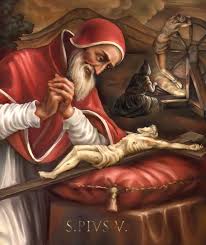
Summary: St Pius V (Antonio/Michaele Ghislieri OP) cleaned up corruption in the papal court, and standardised the training of priests, the liturgy and canon law according to the reforms of the Council of Trent.
 Patrick Duffy outlines his life.
Patrick Duffy outlines his life.
Early career
Born Antonio Ghislieri, of humble origins, near Alessandria in northern Italy, he worked as a shepherd before joining the Dominicans at the age of 14 and took the name Michael. A keen student, he was ordained in 1528 and for sixteen years taught philosophy and theology at Pavia University. He then joined the Inquisition, of which in 1558 he was made the head, meanwhile becoming a bishop and cardinal.
Reforming Pope
In the papal election of 1566 Charles Borromeo successfully lobbied for Ghislieri as a reforming pope. Pius V soon drastically reduced the papal court, stopped nepotism in the appointment of cardinals and imposed strict sexual morality. He also standardised the form of the Mass promulgating the 1570 edition of the Roman Missal which remained standard for 400 years until the reform of Vatican II. (Pope Benedict XVI has recently given permission for this form of the Mass to be used again as an extraordinary form of the Mass. This permisssion was made more restricted recently by Pope Francis)
Excommunicates Queen Elizabeth of England
By the papal bull, Regnans in Excelsis, dated April 27, 1570, he declared Elizabeth I a heretic and released her subjects from their allegiance to her. The second part of this was a less-than-wise excessive claim of papal authority in secular matters. Its effect was to turn Catholics in England and Ireland from religious dissidents to enemies of the state and many had to pay with their lives.
“Holy League” against the Turks
Pope St Pius V persuaded Spain and Venice to join him in a “holy league” against the Ottoman Turks, who at that time controlled the Mediterranean. With Don John of Austria they defeated the Turks at the Battle of Lepanto in 1571.
He attributed the victory to Our Lady and this led
to the cult of Our Lady of Victories and the
establishment of the feast of Our Lady of the Rosary on 7th October.
Death and Memory
Pius was popular with the Romans who admired his inflexible integrity. He died in 1572 and in 1588 and his remains were laid in a magnificent tomb in the Basilica of Saint Mary Major. He was beatified in 1672 and canonised in 1712.
(Pope Francis (right) prays at the relics St Pius V in the Basilica Church of St Mary Major, Rome.)